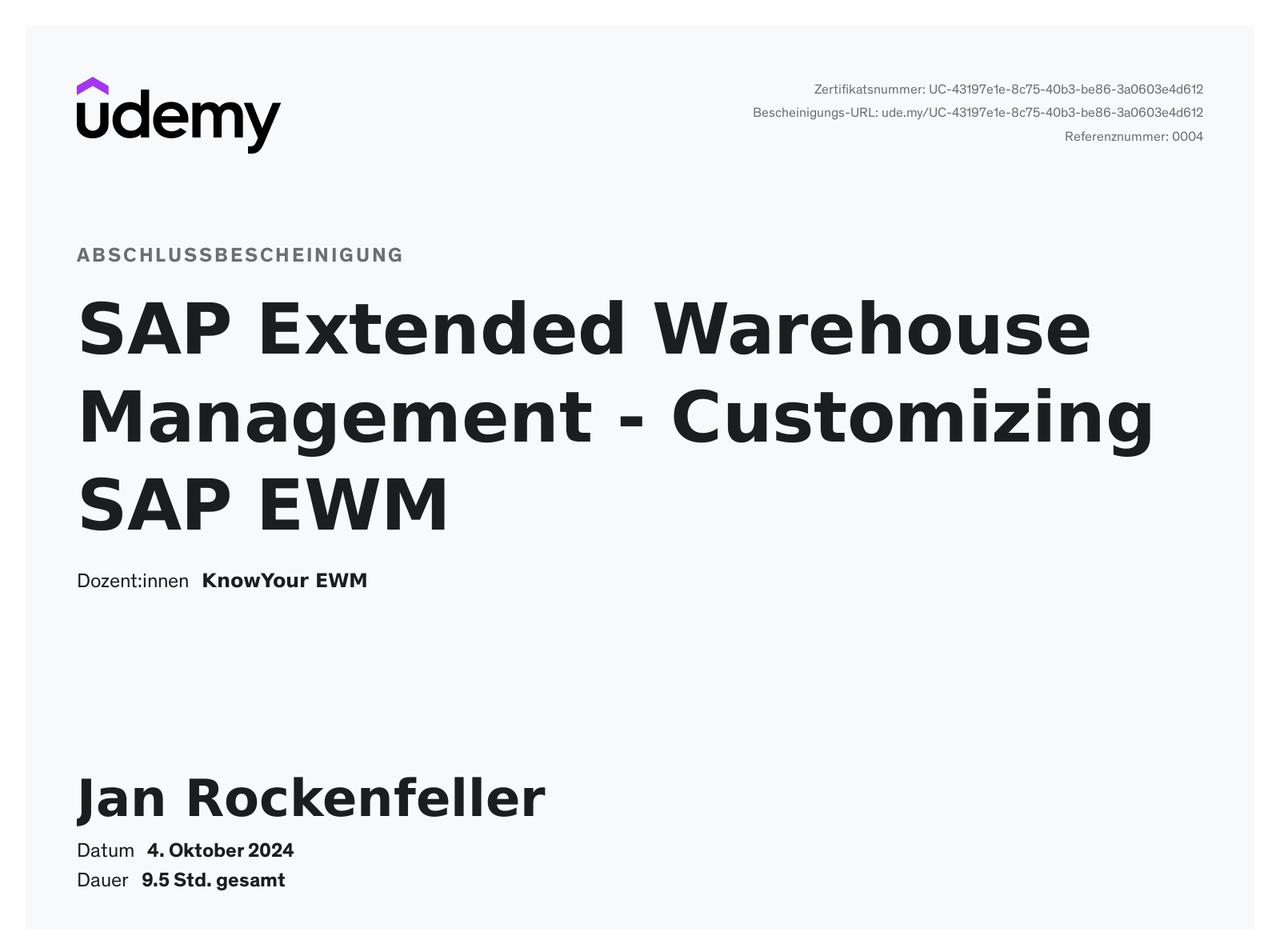Abschnitt 1: Course Introduction – Part 1
1. Introduction
Abschnitt 2: Structural Elements and Master Data
2. Introduction and Goals
3. Warehouse Topology
4. Warehouse Number
5. Supply Chain Unit
6. Storage Types
7. Storage Section
8. Storage Bins
9. Storage Bin Types
10. Activity Area
11. Warehouse Doors
12. Warehouse Product
13. Entitled to Dispose
14. Handling Unit
Abschnitt 3: Warehouse Monitor
15. Customizing the Warehouse Monitor
Abschnitt 4: Warehouse Process Types
16. Introduction and Goals
17. Definition of Warehouse Process Types
18. Warehouse Process Types
19. Determination Indicators
20. Determination of Warehouse Process Types
21. Settings for Warehouse Process Types
22. Performance and Monitoring Pt 1
23. Performance and Monitoring Pt 2
Abschnitt 5: Inbound Process
24. Introduction and Goals
25. Inbound Process Overview
26. Availability Groups
27. ROD/AFS Principle
28. ROD/AFS Principle – Example
29. Storage Bin Determination
30. Storage Bin Determination – Wrap Up
Abschnitt 6: Putaway Strategies
31. Introduction and Goals
32. Storage Type Settings
33. Putaway Strategies – Overview
34. Putaway Strategy – Manual Input
35. Putaway Strategy – Fixed Bin Assignment
36. Putaway Strategy – General Storage Area
37. Putaway Strategy – Addition to existing stock
38. Putaway Strategy – Empty Bin
39. Putaway Strategy – Pallet Storage
40. Conclusion
41. Capacity Checks
Abschnitt 7: Course Introduction – Part 2
42. Introduction
Abschnitt 8: Outbound Process
43. Introduction and Goals
44. Decentralized Outbound Process – Overview
45. Decentralized Outbound Process – Mapping
46. Warehouse Process Types in the Outbound Process
47. Storage Type Determination
48. Stock Removal Strategies
Abschnitt 9: Warehouse Order Creation
49. Introduction and Goals
50. Warehouse Order Creation – Overview
51. Warehouse Order Creation
52. Configuration
53. Sorting, Filters and Limits
54. Warehouse Order Creation Rules – Determination
55. Warehouse Order Creation Rules – Settings
56. Warehouse Order Creation – Example
57. Queues
Abschnitt 10: Physical Inventory
58. Introduction and Goals
59. Physical Inventory Process
60. Types of Physical Inventory
61. Difference Analyzer
62. Tolerance Groups
63. Reports and Transactions
64. Creating, Counting and Posting a Physical Inventory Document
65. The Database for Physical Inventory Documents
Abschnitt 11: Post Processing Framework
66. Introduction and Goals
67. Post Processing Framework – Overview
68. PPF for Delivery Processing
69. Schedule and Start Conditions
70. Practical Example – Customizing
71. Practical Example – Scheduling and Execution
72. Wrap-Up
73. Post Processing Framework & Performance
Abschnitt 12: SAP EWM Performance
74. Performance Introduction
75. SAP EWM Performance
Abschnitt 13: Course Introduction – Part 3
76. Introduction
Abschnitt 14: Posting Changes and Stock Transfers
77. Introduction and Goals
78. Posting Changes vs. Stock Transfers
79. Posting Changes initiated by ERP
80. Posting Changes initiated by EWM
81. Stock Transfers
Abschnitt 15: Storage eControl
82. Introduction and Goals
83. Storage Control Concepts
84. Process-Oriented Storage Control – Basics
85. Process-Oriented Storage Control – Customizing
86. Process-Oriented Storage Control – Determination
87. Layout-Oriented Storage Control
88. Layout-Oriented Storage Control – Customizing and Example
89. Layout-Oriented Storage Control – Pallet Conveyor Systems
Abschnitt 16: Ad-hoc Movements and Replenishment
90. Introduction and Goals
91. Ad-Hoc Movements
92. Replenishment Overview
93. Planned Replenishment
94. Automatic Replenishment
95. Order-Releated Replenishment
96. Direct Replenishment
97. Replenishemnt Execution
98. Replenishment Example
99. Conclusion
100. Storage Bin Determination
